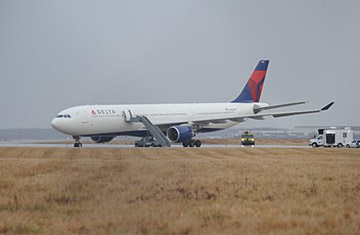
Northwest Airlines Flight 253 arrives at Detroit Metropolitan Airport from Amsterdam on Friday, Dec. 25. Officials say a passenger aboard the plane tried to ignite an explosive device, causing a commotion and minor injuries
With the FBI releasing only sketchy details about the failed attempt to bring down the Northwest Flight 253 in Detroit, many counterterrorism officials and experts caution against hasty conclusions. "This was clearly an attempted terror strike, but it's too early to say whether this guy was a lone, self-motivated terrorist or a part of a larger plot," says one counterterrorism official. "We obviously have to assume the worst and investigate this thing down to the smallest details."
Authorities say Umar Farouk Abdulmutallab, a Nigerian native living in London, tried to light an incendiary mixture strapped to his leg, but instead set himself on fire. He was overpowered by passengers before he could do any further damage. Abdulmutallab has reportedly admitted links to al-Qaeda; he also claimed the plot originated in Yemen. On Saturday, Abdulmutallab was charged with attempting to destroy the aircraft and with placing a destructive device on the plane.
It isn't uncommon for would-be terrorists to claim an al-Qaeda link where one doesn't exist, but counterterrorism experts say several aspects about the Detroit incident point to a pattern:
• The timing: That the attack took place on Christmas Day is especially suggestive, says Georgetown University terrorism expert Bruce Hoffman. "It's worrisome because it fits into the jihadist vision of a war between Islam and Christianity," he says.
• The technique: Officials say Abdulmutallab tried to set off the incendiary mixture as the plane was in its descent to Detroit. This suggests that he was not merely trying to kill the passengers and crew but was probably hoping to make the plane crash in a populated area. The technique also has parallels with "shoe bomber" Richard Reid's failed attempt to bring down American Airlines Flight 63 just three days before Christmas 2001. The FBI affidavit charging Abdulmutallab also indicated that the Nigerian used PETN, the same explosive substance Reid tried to detonate in 2001.
• The Yemen connection: For several years, counterterrorism officials have said that al-Qaeda has been looking to consolidate and expand its base in the country of Osama bin Laden's ancestors. Yemeni authorities, prodded by Washington, have recently mounted an operation to wipe out the terrorist havens — including a missile strike this week that, officials in the Yemeni capital Sanaa say, killed 30 top al-Qaeda operatives. But if Abdulmutallab's plot did indeed originate in Yemen, then it would suggest that much more remains to be done.
• The Nigeria connection: Until now, al-Qaeda's operations in Africa have been concentrated in the east and north. But there have been some sporadic reports of increased Islamic extremism on the west coast. It's not clear whether Abdulmutallab was recruited in London or Nigeria, but if he made contact with al-Qaeda in his home country, then that opens up a new front in the fight against terrorism.
• The Europe connection: That Abdulmutallab was in the U.K. as a student will reignite concern about terrorists sneaking into Europe, and especially Britain, on student visas. In April, British authorities arrested 12 men, 11 of them Pakistanis, for plotting terrorist strikes in Manchester. Several of them were in the country on student visas.
